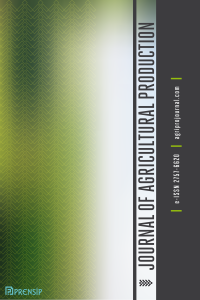Modeling and Forecasting Uganda’s Beef and Cattle Milk Production using the Box-Jenkins Methodology
Modeling and Forecasting Uganda’s Beef and Cattle Milk Production using the Box-Jenkins Methodology
ARIMA, Beef production, Box-Jenkins, Dairy production, Forecasting Uganda,
___
- Agriterra. (2012). Identification of livestock investment opportunities in Uganda. Retrieved Apr 23, 2022, from https://www.agriterra.org/assets/uploads/15820/Livestock%20market%20study.pdf
- Akin, A. C., Tekindal, M. A., Arikan, M. S., & Çevrimli, M. B. (2020). Modelling of the milk supplied to the industry in Turkey through Box-Jenkins and Winters' Exponential Smoothing methods. Veteriner Hekimler Derneği Dergisi, 91(1), 49-60. https://doi.org/10.33188/vetheder.643824
- Asteriou, D., & Hall, S. G. (2007). Applied econometrics. Macmillan International Higher Education.
- Behnke, R., & Nakirya, M. (2012). The contribution of livestock to the Ugandan economy. Retrieved Apr 23, 2022, from https://core.ac.uk/download/pdf/132642444.pdf
- Celik, S. (2019). Modeling and estimation of potato production in Turkey with time series analysis. International Journal of Trend in Research Development, 6(5), 111-116.
- DDA. (2020). Dairy Development Authority annual performance report FY 2019/20. Retrieved Apr 23, 2022, from https://dda.go.ug/assets/files/ANNUAL-PERFORMANCEREPORTFY2019-20.pdf
- DDA. (2021). Dairy Development Authority annual report FY 2020/2021. Retrieved May 1, 2022, from https://dda.go.ug/assets/files/DDA-annulareport20-21.pdf
- Eroğul, N. A., Bozoğlu, M., Topuz, B. K., & Başer, U. (2019). Forecasting the amount of beef production in Turkey. Tarım Ekonomisi Araştırmaları Dergisi, 5(2), 101-107.
- Eştürk, Ö. (2021). Estimating milk production in Ardahan Province with ARIMA (Box-Jenkins) model. Journal of Applied Sciences of Mehmet Akif Ersoy University, 5(2), 271-281. https://doi.org/10.31200/makuubd.972489
- FAO. (2022). Food and Agriculture Organization of the United Nations data (FAOSTAT). Retrieved Apr 28, 2022, from http://www.fao.org/faostat/en/#data
- Ganesan, M., Xavier, G., & Gupta, V. P. (2020). Forecasting of milk production in India by using time series auto regressive moving average model. Shodh Sanchar Bulletin, 10(38), 170-180.
- Gujarati, D. N., & Dawn, C. P. (2009). Basic econometrics. McGrawHill Press.
- Hassan, S. A., Abdelaziz, H. H., Ibrahim, A. H., & Musa, K. S. M. (2018). Milk production -forecasting in Khartoum State, Sudan. Journal of Agriculture and Research, 4(12), 6-13.
- Hill, R. C., Griffiths, W. E., & Lim, G. C. (2018). Principles of econometrics. John Wiley & Sons.
- Hussain, J. N., Alsukmany, A. M., & Mohammed, L. A. (2021). Modelling and forecasting of poultry production in Al-Hilla District in Iraq. PalArch's Journal of Archaeology of Egypt/Egyptology, 18(4), 633-642.
- Kaygisiz, F., & Sezgin, F. H. (2017). Forecasting goat milk production in Turkey using Artificial Neural Networks and Box-Jenkins models. Animal Review, 4(3), 45-52. https://doi.org/10.18488/journal.ar.2017.43.45.52
- Kunst, R. M. (2012). Econometric forecasting. Institute for Advanced Studies Vienna University of Vienna.
- Mahapatra, S., & Satapathy, A. (2019). An application of box-jenkins methodology for forecasting of green gram productivity in Odisha. Journal of Pharmacognosy and Phytochemistry, 8(3), 4383-4387.
- Masood, M. A., Raza, I., & Abid, S. (2018). Forecasting wheat production using time series models in Pakistan. Asian Journal of Agriculture Rural Development, 8(2), 172-177. https://doi.org/10.18488/journal.1005/2018.8.2/1005.2.172.177
- Muhammed, O., & Zengin, Y. (2020). A comparative forecasting approach to forecast animal production: A case of Turkey. Lalahan Hayvancılık Araştırma Enstitüsü Dergisi, 60(1), 24-31.
- Oni, O., & Akanle, Y. (2018). Comparison of exponential smoothing models for forecasting cassava production. International Journal of Scientific Research in Mathematical and Statistical Sciences, 5(3), 65-68. https://doi.org/10.26438/ijsrmss/v5i3.6568
- Putri, R. T., Sukiyono, K., & Sumartono, E. (2019). Estimation of Indonesian Beef Price Forecasting Model. AGRITROPICA : Journal of Agricultural Sciences, 2(1), 46-56. https://doi.org/10.31186/j.agritropica.2.1.46-55
- Rahman, N. M. F., Hasan, M. M., Hossain, M. I., Baten, M., Hosen, S., Ali, M., & Kabir, M. (2016). Forecasting aus rice area and production in Bangladesh using Box-Jenkins approach. Bangladesh Rice Journal, 20(1), 1-10.
- Sánchez-López, E., Pérez-Linares, C., Figueroa-Saavedra, F., & Barreras-Serrano, A. (2015). A short term forecast for Mexican imports of United States beef using a univariate time series model. The Journal of Animal and Plant Sciences, 25(5), 1283-1289.
- Sankar, T. J. (2014). Design of a stochastic forecasting model for egg production. International Journal of Innovative Science, Engineering, and Technology, 1(6), 319-325.
- Suleman, N., & Sarpong, S. (2012). Forecasting milled rice production in Ghana using Box-Jenkins approach. International Journal of Agricultural Management and Development, 2(2), 79-84.
- Taye, B. A., Alene, A. A., Nega, A. K., & Yirsaw, B. G. (2021). Time series analysis of cow milk production at Andassa dairy farm, west Gojam zone, Amhara region, Ethiopia. Modeling Earth Systems and Environment, 7(1), 181-189. https://doi.org/10.1007/s40808-020-00946-z
- UBOS. (2022). Uganda Bureau of Statistics, explore statistics. Retrieved Apr 25, 2022, from https://www.ubos.org/explore-statistics/30/
- UIA. (2016). Uganda Investment Authority, agriculture (Beef). Retrieved Apr 28, 2022, from https://www.ugandainvest.go.ug/wp-content/uploads/2016/02/AGRICULTURE-Beef.pdf
- Waiswa, D., & Akullo, J. (2021). Implications of gender discrimination for household food security among small holder dairy farmers in Nakaloke, Mbale District, Uganda. Research Journal of Agriculture and Forestry Sciences, 9(2), 1-11.
- Waiswa, D., & Günlü, A. (2022). Economic analysis of dairy production in Uganda, a case study on the performance of dairy cattle enterprises in Southwestern Uganda. Asian Journal of Agriculture, 6(2), 61-67. https://doi.org/10.13057/asianjagric/g060202
- Waiswa, D., Günlü, A., & Mat, B. (2021). Development opportunities for livestock and dairy cattle production in Uganda: A review. Research Journal of Agriculture and Forestry Sciences, 9(1), 18-24.
- Başlangıç: 2020
- Yayıncı: Gökhan ARSLAN
Fatih DADAŞOĞLU, Elif TOZLU, Göksel TOZLU, Muhammed TATAR, Recep KOTAN
Effects of Boron Forms and Doses on Germination in Sunflower, Soybean, and Opium Poppy Seeds
Mehmet Demir KAYA, Nurgül ERGİN, Pınar HARMANCI
Impact of Different Shed Houses and Growing Media on Growth, Yield and Quality of Strawberry
Nazrul ISLAM, Ismail HOSSAİN, Shormin CHOUDHURY
Modeling and Forecasting Uganda’s Beef and Cattle Milk Production using the Box-Jenkins Methodology
Aylin TAŞKAYA, Nur CEYHAN GÜVENSEN, Cem GÜLER, Ebru ŞANCI, Ülkü KARABAY
